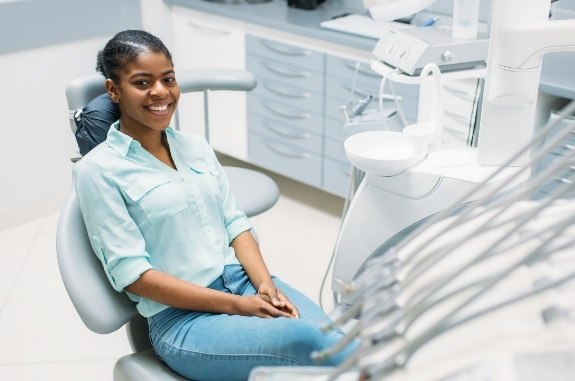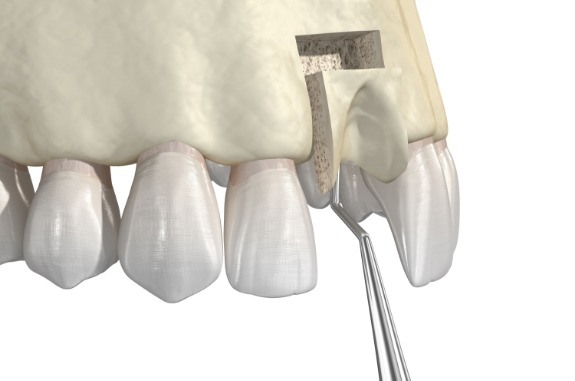Guided Tissue Bone Regeneration – Clute, TX
Restoring Bone Density to Your Jaw
Guided tissue bone regeneration is a procedure that aids in the regeneration of bone and tissues lost because of periodontal disease. Periodontitis or gum disease is a condition in which you suffer from bacterial infection. If you treat periodontitis in its early stages, you may not suffer from much gum or bone decay, and you won’t need guided tissue bone regeneration. But if you don’t treat periodontitis in time, the infection can spread to your gums, and you’ll have to seek bone graft and guided tissue regeneration to make up for the lost tissue. Call our office to discuss the guided tissue regeneration bone grafting procedure in Clute.
Why Choose Woodshore Family Dentistry for Guided Tissue Bone Regeneration?
- Specialty Dental Treatments Performed In-House
- State-of-the-Art Dental Technology
- Dental Team Known for Excellent Customer Service
What Is Guided Tissue Bone Regeneration?

As previously mentioned, guided tissue bone regeneration is a procedure used to regenerate tissues or bone structure after you’ve lost them to periodontitis. The dentist places the membrane or bone graft inside the gum flap of the affected region and near the tooth’s root. As such, the cells from the periosteum reach the root and your tissues start regenerating. The stitches, membrane, and bone graft material will eventually get absorbed by your body once it generates sufficient bone and tissues. This reverses the damage caused by periodontitis and restores oral health.
Guided Tissue Regeneration vs. Guided Bone Regeneration

Bone-guided tissue regeneration and guided bone regeneration help you recover from the damage caused by periodontitis by facilitating the growth of new tissues and bone. However, they differ from each other in the following ways:
- Guided tissue regeneration, as the name suggests, is used to regenerate soft gum tissues. Guided bone regeneration is used to regenerate hard tissues and bone structure.
- Guided tissue regeneration requires the use of soft membranes, whereas guided bone regeneration requires bone grafting material derived from other animals, other parts of your body, other people, or synthetic materials.
- Guided tissue regeneration reverses the damage caused by periodontal disease and it’s not suitable for much else. Guided bone regeneration reverses damage caused by periodontal disease, but it can also be used after tooth extraction to avoid bone loss so you can later get dental implants.
The Necessity of Guided Tissue Regeneration Bone Grafting Procedure

The guided tissue regeneration bone grafting procedure serves two primary purposes:
Reversing the Damage Caused by Periodontitis

Periodontitis, or gum disease, is a condition in which you suffer from a bacterial infection in your mouth due to the excess accumulation of plaque and tartar. When this happens, the bacteria start infecting different parts of your teeth and gums. Over time, periodontitis can cause immense damage. It can lead to the formation of gum abscesses. It can also infect the gums and the bone structure underneath the gums, which can eventually result in bone and gum tissue loss. If this continues, you may eventually lose your teeth as well. Guided tissue regeneration bone grafting procedure treats periodontitis by getting rid of the infected gum tissues and bone. After removing the infected parts, it also facilitates bone and tissue regeneration to restore oral health.
Preventing Bone Loss After Tooth Extraction

When you lose your teeth, either through dental extraction or as a result of gum infection, you start losing bone structure under the socket of the missing tooth as well. In the absence of the tooth, there’s no impetus for the jawbone to continue growing. As such, you can lose 25% of the bone structure within just one year of tooth loss. A bone graft and guided tissue regeneration use bone grafts from different sources to facilitate the regeneration of lost bone and prevent the existing bone from deteriorating. This can be useful in various ways.
Most importantly, bone graft-guided tissue regeneration makes it so that you have sufficient bone structure if you ever decide to get dental implants to replace your missing teeth. Dental implants are the best ways to replace missing teeth because they get firmly rooted in your jawbone and become a part of your body — they even look and function just like real teeth. But the only way to get dental implants is if you have enough bone structure for the metal posts to go through. By preventing bone loss after tooth extraction, this procedure also helps you get dental implants later.
Will Gum Grafts Help Restore My Shrinking Jaw from Bone Loss?

Yes, it is entirely possible to restore your shrinking jaw from bone loss. Guided bone regeneration is primarily meant to be a regenerative procedure that helps with bone growth. If you’re suffering from shrinking jaws, it’s probably because of bone loss caused by missing teeth. During guided bone regeneration, the dentist will place bone grafts in your jawbone to encourage bone regeneration. Over time, your bone will grow naturally and replace the grafted material. This will restore your shrinking jaws and you’ll also be able to get dental implants. The whole process may take a few weeks or even months, depending on the amount of bone you’ve lost.
I Need a Checkup & Cleaning I Need a Dentist for My Child I am Worried About Gum Disease I Have a Cavity or Broken Tooth I am Missing One or More Teeth I Want to Enhance My Smile I Want a Straighter Smile I am Concerned About Sleep Apnea I am Scared of the Dentist I Have Pain in My Jaw I Have a Dental Emergency View Our Services


